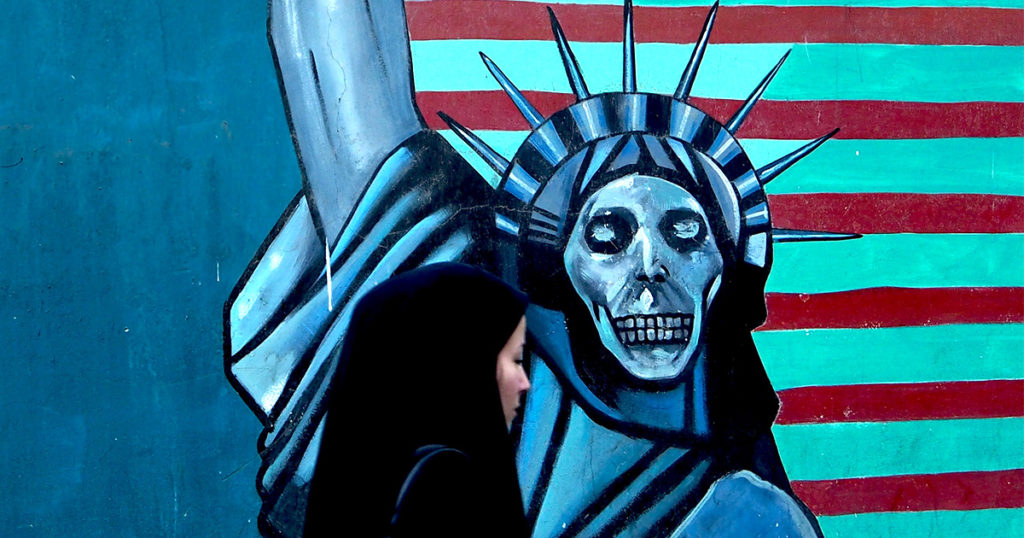
Read Dangerously: The Subversive Power of Literature in Troubled Times by Azar Nafisi; Dey Street Books, 240 pp., $26.99
In Reading Lolita in Tehran (2003), Azar Nafisi recounted how, after being expelled from the University of Tehran for refusing to wear a veil, she invited certain women students to her home on Thursday mornings for discussions of Western literature. In the freedom of her private residence, they would read Lolita, Daisy Miller, and The Great Gatsby. Taboo foreign texts like these provided them the space to examine their own situation in a repressive, misogynistic theocracy.
Nafisi left Iran for the United States in 1997, but she continues to use literary texts to understand herself. Read Dangerously discusses works by Salman Rushdie, Zora Neale Hurston, Toni Morrison, David Grossman, Elliot Ackerman, Elias Khoury, Margaret Atwood, James Baldwin, Ta-Nehisi Coates, and others as mirrors of Nafisi’s own urgent concerns in the age of Covid and Donald Trump. Sitting on her balcony overlooking the Potomac in Washington, D.C., she relishes the luxury to read and write whatever she wants. But as a product of two cultures, Iranian and American, she is keenly aware of the totalitarian mindset that enslaved her native land and is poisoning her adopted country.
Like The Fire Next Time (1936), which James Baldwin addressed to his nephew, and Between the World and Me (2013), which Ta-Nehisi Coates addressed to his son, the book is organized as a series of epistolary meditations. However, unlike the Baldwin and Coates books, which Nafisi discusses, and Rainer Maria Rilke’s Letters to a Young Poet (1929), which she does not, Read Dangerously is aimed at an imaginary reader, the author’s “Baba Jan” (Dear Dad). Her beloved father, Ahmad Nafisi, was mayor of Tehran from 1961 until 1963, when ideological disagreements forced him out of office and into prison for four years. (Nafisi’s mother, Nezhat, one of the first six women seated in the National Consultative Assembly, does not figure in this book.) Nafisi admires and adores her father, who has been dead for about 20 years.
Her letters share with him her enthusiasm for what she has been reading recently and try to fill him in on developments since his death. They include massacres, stonings, and hangings under the regime of the ayatollahs as well as racial violence and a slide into authoritarianism in the United States. “I never imagined,” she writes, “that I would experience this same feeling of fear and helplessness living in the United States as I did in Iran under the Islamic Republic.” But, writing before the 2020 election, she notes “what Trump shares with the leaders of the Islamic Republic: cruelty, incompetence, and a reckless disregard for the lives of the citizens of his country.”
Nafisi doth protest too much when she declares: “I refuse to allow the Islamic Republic to monopolize my thoughts and feelings to such an extent that I cannot not read a work of fiction as a separate entity from my reality.” On the contrary, her readings of Their Eyes Were Watching God (1937), The Handmaid’s Tale (1998), To the End of the Land (2011), and other texts are always filtered through her experience as an emigrant from Iran. With scant attention to structure or style, she is intent on extracting from them ideas that illuminate contemporary threats to freedom and comity in both Iran and the United States. The blatant misogyny of forced marriages and mandatory veils in The Handmaid’s Tale, for example, leads her to insist on similarities between the fictional Republic of Gilead and the all-too-real Islamic Republic. “Both republics persecute women and minorities,” she writes. “Both regard women as feebleminded, subservient to men, their bodies sinful, requiring coverage from head to foot.”
Nafisi observes that “a totalitarian mindset, be it in a theocracy or a democracy, is the enemy of complication, of ambiguity,” and her book is strongest when she wrestles with contradictions—how resisting oppression by dehumanizing one’s adversaries dehumanizes oneself, or how it is possible to reconcile fighting in a war with opposing it. The familiar paradox that reading is most valued in societies that jail and execute poets gnaws at Nafisi; in a society in which anything can be read, poets are ignored. She is disappointed in Americans’ provincialism and intellectual lethargy, their “constant need for entertainment, contempt for history, for thought, for reflection, the political and cultural polarizations and replacement of imagination and ideas with ideology.”
Conventional thinking is hardly endangered by glib generalizations and apodictic truisms, and Reading Dangerously betrays its own central value when it issues bromides that its readers are unlikely to disagree with. “Having been a victim does not justify making victims of others,” she writes. Such a pronouncement hardly makes for dangerous reading. Nor does the observation that “hatred and rage without direction dehumanize not just the enemy but oneself.” Readers of a book titled Reading Dangerously should expect more of a jolt to their dogmatic slumbers.
More effective as bibliophilic pep talk than literary criticism or even memoir, Nafisi’s book celebrates the power of books to humanize their readers, to embrace the values of curiosity, empathy, and decency. She reminds us that that power is often strongest in repressive societies in which reading is insurgency. “In Iran,” she recalls, “we were much more cosmopolitan, reading works from all over the world. Rather sad that the world knows so much about America, while America knows so little about the world.”
Proclaiming that “literature is an act of resistance against dehumanization,” Nafisi ignores those instances in which it is not, in which a master narrative becomes an instrument to validate injustice and subdue free thought. The Clansman, Protocols of the Elders of Zion, and Chairman Mao’s Little Red Book constitute very dangerous reading in ways Nafisi does not begin to explore.

